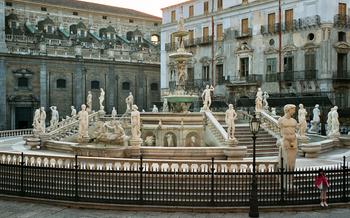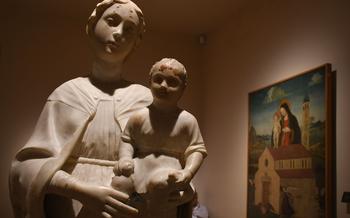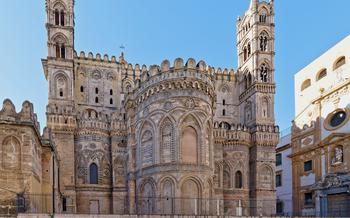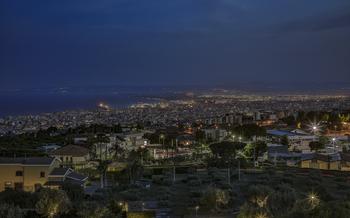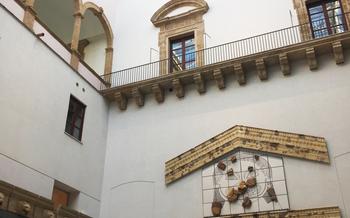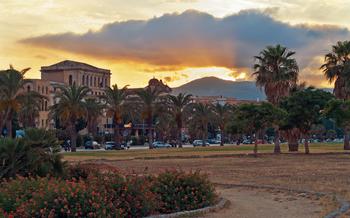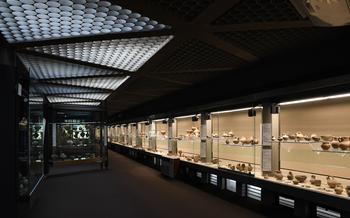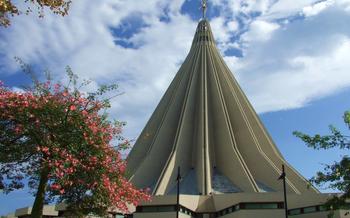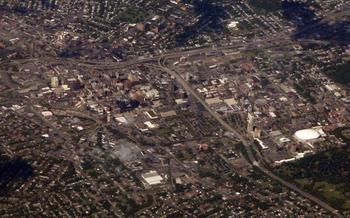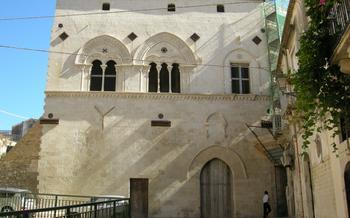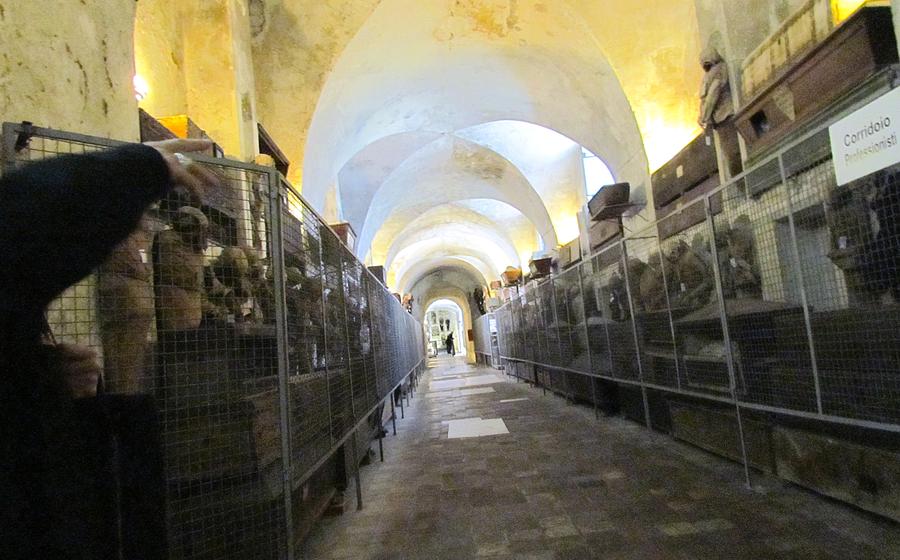
Catacombe dei Cappuccini
- Historical Context
- Architectural Features
- Mummification Process
- Notable Mummies
- Cultural Significance
- Modern-Day Significance
- Practical Information
- Photography and Respect
- Nearby Attractions
- Guided Tours
- Accessibility and Inclusivity
- Educational Programs
- Insider Tip
Historical Context
The Catacombe dei Cappuccini has a rich and intriguing history, dating back to the 16th century. It was originally constructed as a burial site for the Capuchin friars, a Catholic religious order known for its strict adherence to the principles of poverty, chastity, and obedience. The Capuchins believed in the importance of death as a passage to eternal life and sought to preserve their deceased brethren in a manner that would honor their devotion to God.
The catacombs were initially excavated in the soft rock beneath the Capuchin monastery. Over the centuries, they were expanded to accommodate the growing number of friars who wished to be buried there. The catacombs eventually became a repository for the remains of not only Capuchin friars but also members of Palermo's elite, who sought to be interred alongside the holy men.
Architectural Features
The Catacombe dei Cappuccini is a testament to the architectural prowess of the Capuchin friars. Constructed in the 16th century, the catacombs feature a network of underground chambers, each adorned with intricate carvings, vaulted ceilings, and Baroque-style decorations.
The main corridor, known as the "Corridoio dei Misteri," is lined with niches that house the mummified remains of friars and prominent citizens of Palermo. The walls are adorned with frescoes depicting scenes from the life of Christ, adding a touch of sacred beauty to the otherwise somber surroundings.
One of the most striking features of the catacombs is the "Cappella delle Teste," or Chapel of the Skulls. This small chapel is filled with thousands of skulls and bones, arranged in intricate patterns and designs. The sight is both awe-inspiring and unsettling, reminding visitors of the inevitability of death and the fragility of human life.
The catacombs also feature a variety of other chapels and chambers, each with its own unique character and decorations. Visitors can explore the "Cappella delle Piccole Suore," which contains the mummified remains of young girls who died in the 19th century, or the "Cappella dei Putridari," where the bodies of friars were left to decompose before being mummified.
Mummification Process
The Capuchin friars employed a unique mummification process to preserve the bodies of their deceased brothers. The process involved several stages and techniques. First, the bodies were washed and dried, then placed in a sitting position inside a wooden box filled with salt. The salt absorbed the body's moisture, further drying it and inhibiting decomposition. After several months, the bodies were removed from the salt and hung upside down to drain any remaining fluids.
Next, the bodies underwent a process of natural mummification, aided by the cool, dry conditions of the catacombs. Over time, the bodies' skin and organs shrank, and their muscles and tendons hardened. This natural mummification process could take up to two years.
In some cases, the friars used additional techniques to preserve the bodies. They might apply a mixture of wax and resin to the skin to create a protective layer. They might also stuff the bodies with straw or rags to maintain their shape and prevent collapse.
As a result of these mummification techniques, the bodies in the Catacombe dei Cappuccini have been remarkably well-preserved. Many of them still have their hair, teeth, and even their clothes intact. The mummies provide a fascinating glimpse into the lives and deaths of the Capuchin friars who inhabited the monastery centuries ago.
Notable Mummies
Among the thousands of mummies interred in the Catacombe dei Cappuccini, several stand out for their unique stories and intriguing lives. One such mummy is that of Rosalia Lombardo, a two-year-old girl who died in 1920. Remarkably well-preserved due to a special embalming technique, Rosalia's mummy appears to be sleeping peacefully, earning her the nickname "Sleeping Beauty." Visitors are often awestruck by her lifelike appearance and the poignant beauty of her delicate features.
Another notable mummy is that of Mariano Palermo, a circus performer who was known for his incredible flexibility and acrobatic skills. Palermo's mummy showcases his contorted posture, frozen in time as if he were still performing one of his daring feats. His mummified remains serve as a haunting reminder of his extraordinary abilities and the fleeting nature of life.
The catacombs are also home to the mummies of several Capuchin friars, each with their distinct story. Some friars were highly respected for their piety and wisdom, while others were known for their eccentricities or unusual habits. The mummies of these friars offer a glimpse into the lives of the Capuchin order and the diverse personalities that inhabited the catacombs.
Cultural Significance
The Catacombe dei Cappuccini holds immense cultural and historical significance, serving as a testament to the beliefs, practices, and attitudes towards death and mortality that shaped the Capuchin order and the people of Palermo. The catacombs offer a unique glimpse into the lives and customs of the Capuchin friars, who dedicated themselves to a life of poverty, humility, and contemplation.
The elaborate mummification process and the preservation of the bodies reflect the Capuchins' belief in the resurrection of the dead and their desire to maintain a connection with their deceased brethren. The mummies serve as a reminder of the transience of life and the inevitability of death, while also highlighting the importance of honoring and remembering the departed.
The catacombs also shed light on the broader cultural attitudes towards death and mortality in Palermo during the 16th to 19th centuries. The elaborate decorations, Baroque-style artwork, and careful arrangement of the mummies suggest that death was not seen as a taboo subject but rather as a natural part of life. The catacombs served as a place for reflection, prayer, and remembrance, where the living could connect with the dead and seek spiritual guidance.
In modern times, the Catacombe dei Cappuccini continues to captivate visitors with its unique blend of history, art, and cultural significance. The catacombs serve as a reminder of the fragility of life, the importance of death rituals, and the enduring power of human memory.
Modern-Day Significance
The Catacombe dei Cappuccini, once a secluded burial site for Capuchin friars, has transformed into a prominent tourist attraction and a vital site for research and education. The well-preserved mummies continue to captivate visitors with their intricate stories and provide a unique glimpse into the past.
In contemporary society, the catacombs hold a profound significance as a testament to the fragility and beauty of life. They serve as a reminder of the mortality shared by all, regardless of social status or wealth. Visitors are encouraged to reflect on their own mortality and the legacy they wish to leave behind.
Academic researchers and historians find immense value in studying the catacombs. The mummified bodies provide a wealth of information about the health, diet, and lifestyle of individuals who lived centuries ago. Researchers also explore the cultural and religious significance of the catacombs, shedding light on the practices and beliefs of the Capuchin order.
The Catacombe dei Cappuccini has become a symbol of Palermo's rich history and cultural heritage. It attracts visitors from around the world who seek to experience the unique and macabre atmosphere of this extraordinary site. The enduring fascination with the catacombs ensures their continued relevance in modern times.
Practical Information
To visit the Catacombe dei Cappuccini, plan your trip during its opening hours, which are generally from 9 AM to 1 PM and from 3 PM to 5 PM, Tuesday through Sunday. Keep in mind that the catacombs may be closed on certain holidays and during special events.
For admission, a modest fee is charged, which helps maintain and preserve this unique heritage site. Guided tours are available in various languages and offer an in-depth exploration of the catacombs' history, culture, and significance. It's advisable to book your guided tour in advance, especially during the busy tourist season, to avoid disappointment and ensure a spot.
Remember to dress respectfully when visiting the catacombs, as it is a place of reverence and contemplation. Comfortable shoes are recommended for navigating the underground chambers and corridors. If you have any specific questions or accessibility concerns, don't hesitate to contact the Catacombe dei Cappuccini directly for assistance.
Photography and Respect
While exploring the Catacombe dei Cappuccini, it is crucial to remember that you are in a place of eternal rest for the deceased. Therefore, it is essential to show respect and sensitivity towards the mummies and their families. Photography is permitted within the catacombs, but visitors should be mindful of the following guidelines:
-
Respect the privacy of the deceased: Avoid using flash photography or taking close-up shots of the mummies' faces.
-
Be considerate of other visitors: Keep your voice low and avoid disturbing others who are paying their respects or contemplating the significance of the catacombs.
-
Follow the instructions of the staff: The catacombs' staff may provide specific guidelines or restrictions regarding photography. Always follow their instructions to ensure a respectful and orderly visit.
By adhering to these guidelines, you can help preserve the sanctity of the Catacombe dei Cappuccini and show respect for the departed souls and their families.
Nearby Attractions
Palermo offers a wealth of other captivating attractions that visitors can explore before or after delving into the Catacombe dei Cappuccini's depths. The Palermo Cathedral, with its majestic Arab-Norman architecture, stands as a testament to the city's rich history and is a must-visit for any traveler. The Palazzo dei Normanni, the seat of the Sicilian Regional Assembly, boasts stunning mosaics, opulent halls, and the renowned Cappella Palatina, a masterpiece of Byzantine art.
For those seeking a taste of Palermo's vibrant street life, the Mercato di Ballarò, one of the city's oldest and most vibrant markets, offers a sensory feast of colors, sounds, and aromas. Here, visitors can haggle for fresh produce, sample local delicacies, and soak up the infectious energy of this bustling marketplace.
Art enthusiasts will find much to admire at the Galleria Regionale della Sicilia, which houses a significant collection of Sicilian art from the Middle Ages to the contemporary era. The Museo Archeologico Regionale Antonio Salinas offers a journey through Sicily's ancient past, with its impressive collection of artifacts from prehistoric, Greek, and Roman periods.
Immerse yourself in the tranquility of the Giardino Inglese, a sprawling botanical garden with a delightful mix of exotic and indigenous flora. Take a leisurely stroll along its winding paths, marvel at the diverse plant life, and find a serene spot to relax and soak in the beauty of nature.
These attractions, combined with the Catacombe dei Cappuccini, provide a diverse and enriching experience for visitors exploring the captivating city of Palermo.
Guided Tours
Guided tours of the Catacombe dei Cappuccini are highly recommended for visitors seeking a deeper understanding of the history, culture, and significance of this unique site. Knowledgeable guides provide insights into the lives of the Capuchin friars, the mummification process, and the stories behind some of the most famous mummies.
Guided tours typically cover the highlights of the catacombs, including the underground chambers, notable mummies, and the Baroque-style decorations. Guides also provide historical context and answer questions, allowing visitors to gain a more comprehensive understanding of the catacombs and their cultural significance. Booking a tour in advance is advisable to secure a spot and avoid disappointment, especially during peak tourist season.
Accessibility and Inclusivity
The Catacombe dei Cappuccini is committed to providing an accessible and inclusive experience for all visitors. The catacombs are wheelchair accessible, and visitors with disabilities or limited mobility can request assistance from the staff. Guided tours are also available in multiple languages to accommodate visitors from different backgrounds. For visitors who are deaf or hard of hearing, sign language interpreters can be arranged upon request. The catacombs also offer educational programs and workshops that are designed to be accessible and inclusive for all participants. Visitors with specific accessibility needs are encouraged to contact the catacombs in advance to inquire about accommodations and arrangements. The catacombs strive to create a welcoming and inclusive environment where everyone can learn about and appreciate the unique heritage of this fascinating site.
Educational Programs
The Catacombe dei Cappuccini offers a range of educational programs and workshops to promote cultural heritage and understanding. These programs provide visitors, particularly students and researchers, with opportunities for in-depth exploration of the catacombs' history, traditions, and significance.
One notable program is the Guided Educational Tour, which offers a tailored experience for school groups and educational institutions. Led by expert guides, these tours delve into the history of the catacombs, the mummification process, and the cultural practices of the Capuchin friars. Interactive activities and discussions encourage students to engage with the site and its stories.
The Catacombs also host specialized workshops and seminars on topics related to death, mummification, and the cultural history of Palermo. These workshops are led by historians, anthropologists, and other experts who share their knowledge and insights with participants.
By participating in these educational programs, visitors can gain a deeper appreciation for the Catacombe dei Cappuccini and its unique contribution to our understanding of history, culture, and the human experience.
Insider Tip
As you explore the Catacombe dei Cappuccini, take a moment to notice the small, handwritten notes tucked into the hands of some of the mummies. These notes, often written by family members or friends, offer a glimpse into the lives and relationships of the deceased. They express love, sorrow, and remembrance, providing a deeply personal and touching connection to the individuals who once walked the streets of Palermo.
